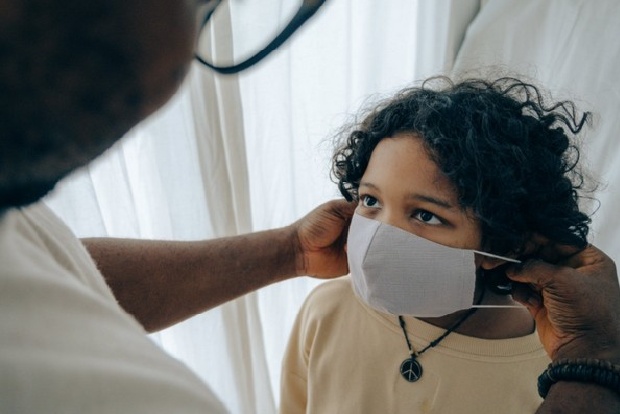The study was conducted before the highly contagious omicron variant became the predominant strain of Covid-19 in the United States.
A new study revealed that child care programs in the United States that practiced child masking early in the COVID-19 pandemic (May-June 2020) experienced a 13 per cent reduction in program closure within the following year, and continued child masking throughout the one-year study period was associated with a 14 per cent reduction in program closure. The first-of-its-kind study of child masking, was published in ‘JAMA Network Open’, a peer-reviewed journal of the American Medical Association.
It followed the experiences of 6,654 center-based and home-based child care professionals from all 50 states during a one-year period (May/June 2020 through May/June 2021). It was part of a series of studies aimed at informing policies regarding the health and wellbeing of children in child care programs, as well as the 1.1 million child care professionals who care for them.
This study has been believed to be the first large-scale longitudinal study of the potential effects of various safety measures used to reduce the spread of COVID-19 in child care programs and keep this essential service open for working families. These findings come at a time when child masking in schools and child cares continues to be hotly debated, particularly as a surge in cases related to the omicron variant has led to a wave of child care disruptions, affecting millions of American families.
During the study period, 43 per cent of child care programs had closed at least temporarily due to a suspected or confirmed case of COVID-19 in either a child or staff member, researchers said. Although several safety measures were studied (e.g., adult and child masking, 6-foot distancing, staggered arrivals and departures, outdoor drop-off and pick-up), child masking emerged as the strategy most associated with reduced child care closure rates, keeping children in safe learning and care environments and allowing working parents and child care providers to remain employed, researchers said. Six-foot distancing of seating and cots in child care facilities, when used over the one-year period, was associated with a 7 per cent reduction in the odds of COVID-19-related child care closure. The study controlled for the degree of local COVID-19 transmission in the community.
“We have been seeing increased numbers of children, especially young children not yet able to be vaccinated against COVID-19, admitted to our children’s hospital,” said Thomas Murray, associate medical director for infection prevention at Yale New Haven Children’s Hospital and the study’s lead author. “It is heartening to know that following child masking recommendations for children two years and older may be an effective means for keeping young children in child care programs and potentially lowering their risk for COVID-19.”
Although the study provided encouraging evidence for the effectiveness of child masking, only 9 per cent of child care programs required children two years and older to wear face masks during the early months of the COVID-19 pandemic. That percentage increased to 33 per cent by May and June 2021. Masking rates were much higher for staff members, with 64 per cent reporting that all adult staff were wearing masks in May and June 2021. Research has shown that children two years and older can safely wear masks in child care settings. “It’s the disruptions in learning opportunities and care routines that harm children, not the masks,” said Walter Gilliam, a professor of child psychiatry and psychology at the Yale Child Study Center and the study’s senior author.
“It is our responsibility to protect our young children by providing them with safe learning environments,” Gilliam said. “We need to remember that young children are incredibly observant. If they cannot see us smile with our mouths, they still will see us smile with our eyes or in the way in which we talk with them. Masks don’t harm children; COVID-19 does.” Previous research from the Yale team, released in August 2021, showed that 78 per cent of child care providers are vaccinated against COVID-19, a rate significantly higher than the general population at that time (65 per cent). However, most children in child care programs are under five years old and not yet eligible for COVID-19 vaccination. This leaves these young children more vulnerable for complications due to COVID-19. “Until children under five years old are able to be vaccinated against COVID-19, they are a particularly vulnerable population,” said Murray, a pediatric infectious disease expert. “We need to ensure that the adults and older children around them are vaccinated and following other proven precautions for keeping young children safe, such as having children two years and over wearing facial masks when in congregate settings like child care programs.”
The study was conducted before the highly contagious omicron variant became the predominant strain of COVID-19 in the United States. “It is possible that child masking may be even more important during the current surge of cases caused by omicron,” explained Dr. Murray. The study comes at a time when child care programs are experiencing increased staffing shortages due to a spike in COVID-19 cases, which further threatens the vulnerable child care infrastructure — and when much-anticipated funding increases for early care and education is stalled in the U.S. Senate. Child care closures due to COVID-19 illnesses and staffing challenges have made it very difficult for working parents to sustain employment. These closures also harm the ability of young children to benefit from the important social and early learning opportunities provided by a stable, safe, and caring early childhood program, researchers said.
“We know that children benefit from in-person learning opportunities, and this includes young children, and we know that many parents rely on child care in order to go to work,” said Gilliam, an expert on child care and early childhood policy. “Child masking will not eliminate all child care closures, but it may help reduce some of them, keeping our young children with caring adults who support their learning and development. ” Child care professionals have had it very rough these past two years,” Gilliam added. ” They struggle to obtain even simple things like access to COVID-19 testing, masks, and pay protection during inevitable closures. We show how much we care for our children through how well we support these child care professionals who are doing their best in very trying times to keep our young children safe and well.”



















